Dinner's ready: Four wholesome recipes perfect for family celebrations
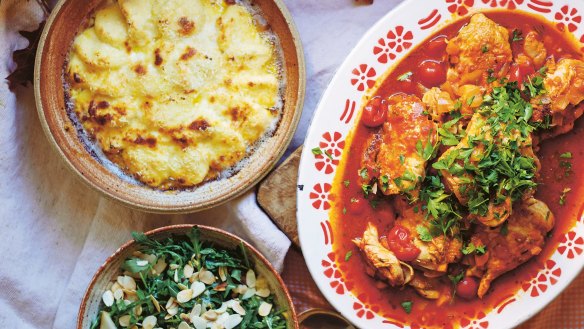
Food is a powerful way to communicate what we love, need and feel to the people around us, says NSW farmer and food writer Sophie Hansen and her mum, art teacher Annie Herron.
The pair's new cookbook, Around the Kitchen Table, celebrates this connection, with each recipe an invitation to pause our busy lives and cook or create something satisfying with our hands.
"It's our call to the kitchen table, a wave to come over, sit down and chop, stir, knead, draw, paint, weave or stitch with us," they write.
Here the duo share a spread of heart-warming recipes perfect for Mother's Day, or any day of the year.
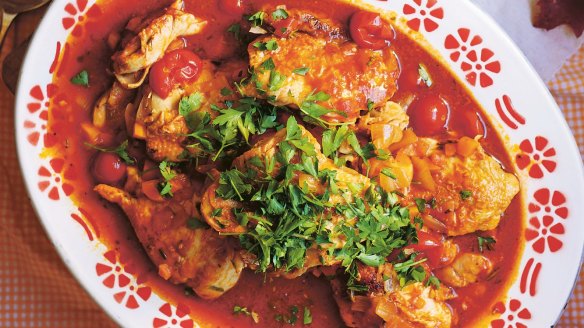
Angela's chicken
Unctuous, rich and aromatic, this simple chicken dish is one of my favourite things to have for Sunday lunch, especially when served with deliciously golden and cheesy semolina gnocchi.
INGREDIENTS
- 1 whole chicken, jointed into 8 pieces (you can ask your butcher to do this for you)
- ¼ cup (35g) plain flour
- about 2 tbsp olive oil
- 2 tbsp (40g) butter
- 1 brown onion, finely chopped
- 1 carrot, peeled and finely diced
- 1 celery stalk, finely diced
- 3 unpeeled garlic cloves, bruised with the back of a knife
- 1 rosemary stalk
- 1 cup (250ml) white wine
- 400g can cherry tomatoes
- 2 tbsp tomato paste
- ½ cup (125ml) chicken stock
- roughly chopped parsley, to serve
METHOD
- Toss the chicken pieces with the flour and season well.
- Heat the oil and butter in a large flame-proof casserole dish over high heat until bubbling. Brown the chicken in batches, cooking for a few minutes on each side or until golden all over. Transfer the chicken to a plate and set aside.
- Return the pan to medium-low heat. Add a little more oil, if needed, then add the onion, carrot, celery, garlic and rosemary, and season with a little salt and pepper. Cook, stirring often, for 20 minutes or until the vegetables have reduced right down and have an almost jammy consistency.
- Pour in the wine and tomatoes and cook, stirring, until the liquid has reduced by half. Stir in the tomato paste. Return the chicken pieces to the pan and pour in the stock. Reduce the heat to low, cover and cook for 45 minutes. Check the liquid halfway through cooking and add a splash of water if needed.
- Remove the pan from the heat and let the chicken rest for a few minutes before sprinkling it with the parsley. Serve the chicken with a green salad, semolina gnocchi and some dinner rolls.
Serves 4-6
Dark chicken stock
INGREDIENTS
- 1 large free-range chicken
- 2 brown onions, quartered
- 3 carrots, cut into chunks
- 2 celery stalks, cut into chunks
- olive oil, for drizzling
- 1 handful rosemary and thyme sprigs (a mix is nice, but use whatever you have in the garden or fridge)
- 1 bay leaf
- ¼ cup (60ml) boiling water
- ¼ cup (60g) tomato paste
METHOD
- Preheat the oven to 200C fan-forced (220C conventional). Cut the chicken in half right down the middle and lay it flat in a roasting tin. Surround the chicken with the onion, carrot and celery. Drizzle everything with olive oil and season with salt and pepper, then pop it into the oven for 20 minutes or until the chicken and aromatics have browned nicely.
- Transfer everything from the tin into a large stockpot or saucepan and pour in 14 cups (3.5 litres) water. Add the herbs and bay leaf and bring to the boil, skimming any foam or scum that rises to the surface. Reduce the heat to a low simmer and cook for 1½ hours.
- Meanwhile, deglaze the roasting tin by placing it on the stove over medium heat (or scrape everything you can from the base of the tin into a saucepan) and adding the boiling water, scraping and stirring so you get all the colour and flavour from the bottom of the tin. Stir in the tomato paste, then pour the mixture into the stock.
- Strain the stock and refrigerate or freeze it. Discard the vegetables. Once the chicken is cool enough to handle, shred the meat and store it in an airtight container in the fridge. (Purists might argue that the chicken will be a touch overcooked, but actually I find it super tasty.)
Note To make a reduction jus, pour 2 cups (500ml) of this rich, unctuous stock into a saucepan and cook it over medium heat until it reduces by half. This is beautiful as a gravy for roast chicken or even to use when making a gravy for roast lamb.
Makes about 8 cups (2 litres) stock and 400g cooked chicken
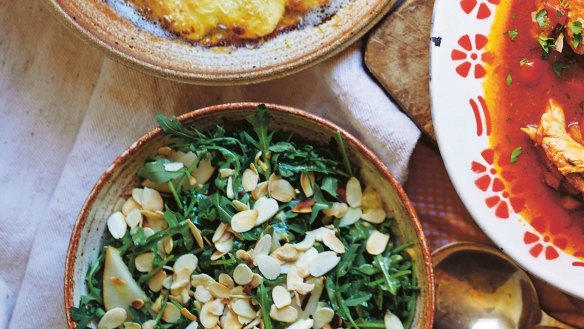
Green salad
Gather a mix of greens, such as rocket, mizuna, oak leaf lettuce, radicchio, sorrel and soft herbs, and separate the leaves from their stems. Wash the leaves, then give them a good shake in a sieve or colander. Gently roll up the leaves in a couple of clean tea towels, then pop them in the fridge until lunch or dinnertime.
Tip the leaves into a serving bowl. Lightly sprinkle with salt, then dress with a classic vinaigrette, made by mixing one part vinegar with three parts extra virgin olive oil. Finish with some toasted flaked almonds and thinly sliced crisp pear. Toss and serve.

Baked semolina gnocchi
Very forgiving, very delicious and very soothing, this semolina gnocchi is a total winner and I'd happily have it for dinner on a cold, windy night, just on its own. It's also a fantastic side dish for all kinds of mains. Everything is done in advance and you can have it sitting in the fridge, ready to pop into the oven 40 minutes or so before it's time to eat.
We are jumping around a bit geographically with this dish – it's a Roman classic, while the chicken and the chocolate salami are Piedmontese staples, but as with most of my cooking, it's an amalgamation of flavours and memories. As long as the end result is tasty and proper credit is given to the recipe's origins, that's OK with me.
INGREDIENTS
- 2 eggs, lightly whisked
- 1 cup (180g) semolina
- 2 cups (500ml) full-cream milk
- 1 cup (100g) grated parmesan cheese
- ¼ tsp freshly grated nutmeg
- ¼ cup (60g) butter, cut into cubes, plus extra for greasing
- ⅓ cup (80ml) single cream
METHOD
- Combine the eggs and semolina in a saucepan and whisk well. Whisk in the milk, half the parmesan and the nutmeg. Cook over medium heat, stirring constantly, for about 5 minutes or until the mixture thickens to a porridge consistency and comes away from the side of the pan. Remove from the heat and set aside to cool for about 5 minutes.
- Turn the semolina mixture out onto a work surface and divide it in half. Using damp hands, roll each half into a long sausage shape. Wrap each log in plastic wrap and place in the fridge to chill for 30 minutes.
- Preheat the oven to 200C fan-forced (220C conventional). Butter a shallow ovenproof dish. Unwrap the semolina logs and slice them into rounds 1cm thick. Arrange the rounds in the buttered dish, overlapping them. Dot the butter over the gnocchi, drizzle with the cream and sprinkle with the remaining grated parmesan. Bake for 20 minutes or until the gnocchi has puffed up a little and the cheese on top is golden and bubbling.
Serves 4
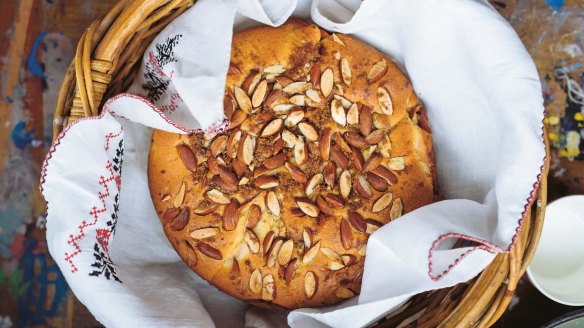
Snacking cake
I love the idea of a snacking cake – a lovely slab that sits in the cake tin for a few days, just waiting to be cut and eaten with a cup of tea. It's not fussy, just plain yet delicious, and a good vehicle for any kind of fruit, preserved or fresh. If that sounds good to you, then this is your cake! The quantities I've given do make quite a large cake, so if you think your household might snack less than mine, please go ahead and halve them.
INGREDIENTS
- 320g unsalted butter, softened
- 2¾ cups (420g) plain flour
- 200g caster sugar
- 2 tsp baking powder
- a good pinch of salt
- ½ cup (130g) Greek-style yoghurt
- 4 eggs
- ½ cup (50g) flaked natural almonds
- ¼ cup (45g) brown sugar
Filling
- 4-5 apples, pears or a similar quantity of preserved fruit, halved and sliced (see note)
- 2 tbsp white sugar
- juice of 1 lemon
METHOD
- Preheat the oven to 180C fan-forced (200C conventional). Grease and line a 30 x 20cm cake tin with baking paper.
- Combine the butter, flour, sugar, baking powder and salt in an electric mixer fitted with the paddle attachment. Beat on low until the mixture just comes together. Add the yoghurt and eggs and beat on low speed for 10 seconds or until the mixture just comes together, then increase the speed and beat for a few minutes until the batter is light and fluffy.
- Meanwhile, make the filling. Place the sliced apples or pears in a bowl with the sugar. Squeeze in the lemon juice, then toss to combine.
- Spread about half of the batter in the cake tin in a smooth layer, top with the fruit and then add the remaining batter. Smooth the top and sprinkle it with the flaked almonds and brown sugar. Pop the cake into the oven for about 45 minutes or until the centre is springy to the touch. Leave in the tin to cool for 5 minutes, then gently turn it out onto a wire rack to cool completely. If the cake is quite fruit-heavy, you could cool and store it in the tin as the fruit makes it more fragile and likely to break up as you turn it out.
Note You can swap the apples for any other fresh or preserved fruit. If you're using preserved fruit, there's no need to toss it with the sugar and lemon juice – simply spread it over the batter.
Serves 8-10

Honey jumbles
The stuff of childhood nostalgia, these honey jumbles are such a favourite in my house. And they're a simple melt-and-mix recipe, so are a good opportunity to get the kids involved in baking. I've topped these with orange-flavoured icing, but you could stay with the classic option and do half pink and half white (in which case, just omit the orange juice and zest and use a little lemon juice for the white icing and a tiny drop of pink food colouring for the pink).
INGREDIENTS
- ¼ cup (65g) unsalted butter
- ½ cup (175g) honey
- ¼ cup (45g) brown sugar
- 1 tsp vanilla bean paste
- 1½ cups (225g) plain flour, plus extra for dusting
- ½ tsp bicarbonate of soda
- ½ tsp ground cinnamon
- ½ tsp ground ginger
- a pinch of freshly ground nutmeg
- a pinch of ground cloves
- 1 tbsp milk
Orange icing
- 1 egg white
- 1½ cups (185g) icing sugar
- grated zest and juice of 1 orange (see note)
METHOD
- Combine the butter, honey, brown sugar and vanilla in a small saucepan over medium heat. Cook, stirring, for a few minutes or until the mixture has melted into a thick caramel. Remove from the heat and set aside to cool for 5 minutes.
- Sift the dry ingredients into a bowl. Pour in the butter mixture and milk and stir until well-combined. Cover the dough and pop it into the fridge to chill for 1 hour.
- Preheat the oven to 160C fan-forced (180C conventional). Line two baking trays with baking paper.
- Divide the dough into four pieces. Roll out one piece into a 15cm long sausage on a lightly floured surface. Cut the sausage into three pieces and flatten each into an oval shape. Place on the tray, leaving room for spreading. Repeat with the remaining dough.
- Bake the biscuits for 8-10 minutes or until they have puffed up a little and are dry to the touch. Transfer to a wire rack to cool.
- For the icing, whisk the egg white in a small bowl until foamy. Sift in the icing sugar, then add the orange zest and juice, a little at a time, and whisk until the mixture is smooth and thick.
- Spoon about 1 teaspoon of icing onto each biscuit and gently spread to cover. Store the biscuits in an airtight container for up to a week.
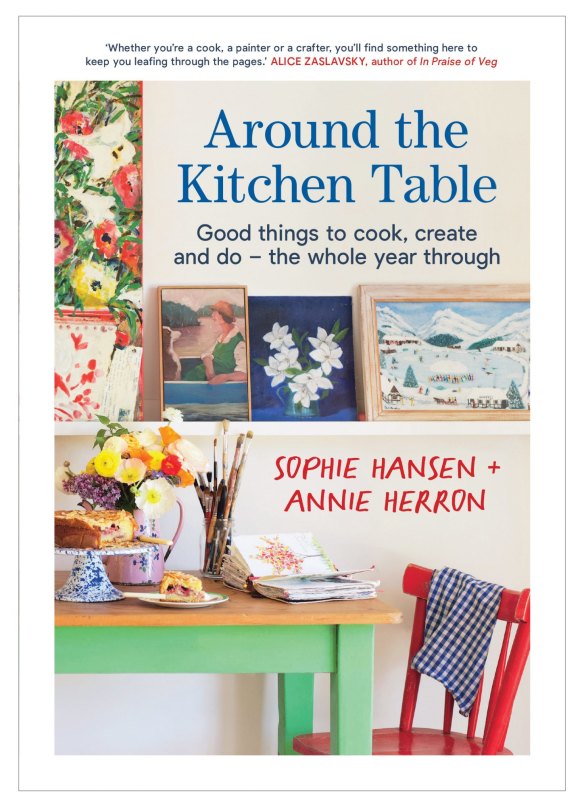
Note If available, use a blood orange to make the icing – it will add colour and some extra tang.
Makes about 12
This is an edited extract from Around the Kitchen Table by Sophie Hansen and Annie Herron, photography by Sophie Hansen. Murdoch Books, RRP $39.99. Buy now